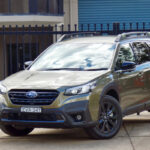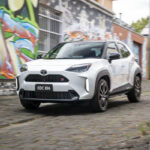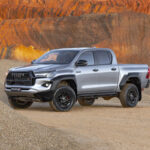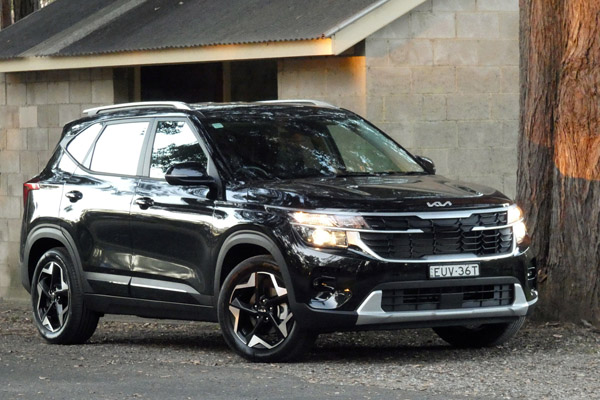
Kia now offers four SUVs of which Seltos (oddly they all start with the letter S) is the
second smallest.
At one stage we were contemplating the purchase of a Seltos as a replacement for our
ageing Sportage which has finally run out of warranty.
The big attraction was its size and price because along with its growth in size and prestige,
Sportage has piled on the dollars.
Though it’s a smaller car, Seltos offers plenty of utility for two people and these days the
petrol engine gets better fuel consumption than our diesel.
It’s up against the likes of MG ZS, Haval Jolion and Mitsubishi Eclipse Cross, which are
the frontrunners in the segment – not to mention Hyundai’s own Kona (same company).
STYLING
Seltos was updated towards the end of last year. The exterior design has been refreshed
front and back, with new look headlights, a larger bolder radiator grille and new front
bumper design.
Even the entry S now gets alloys while top of the line GT-Line sports a new DRL design —
in fact it’s the only one with daytime LEDs. The rear has also been tweaked with new tail
lights, joined by a reflector strip or a line of LEDs in the case of GT-Line.
All versions get roof rails, a rear spoiler and folding, body-coloured side mirrors with
integrated indicators.
The name of the game is keeping pace with the opposition, because any car that does not
continue to evolve will be left behind.
Two engines are offered: a 2.0-litre naturally aspirated unit, available across all four
grades, while Sport+ and GT-Line are also available with a revised 1.6-litre turbo together
with all-wheel drive.

The 2.0-litre unit is paired with a CVT, while the turbo now gets a conventional eight-speed
auto instead of the previous dual clutch transmission.
Prices start from $29,500 for the 2.0-litre, front-wheel drive S, rising to $41,500 for GT-
Line. Taking it up a notch, turbocharged Sport+ and GT-Line are priced from $39,300 and
$44,900 respectively.
Our test vehicle, the 2.0-litre front-drive Sport+ is $35,800 – or $38,490 driveaway.
Standard kit includes 17-inch alloys, single zone climate air with rear vents and
combination cloth and artificial leather trim, with a premium steering wheel and shift knob,
plus LED interior lighting.
There’s also auto high beam, adaptive cruise control, auto lights and an auto dimming
interior mirror, front and rear parking sensors and an electric parking brake with auto hold –
– but it misses out on automatic wipers.
INFOTAINMENT
Infotainment comes in the form of an 8.0-inch touchscreen in the entry S while the others
get a pair of 10.25-inch screens embedded in a single sweeping instrument panel.
There’s also Bluetooth, voice control, satellite navigation, AM/FM/DAB+ digital radio, and
wired Apple Carplay and Android Auto, Sounds of Nature background noise, together with
six-speaker audio.
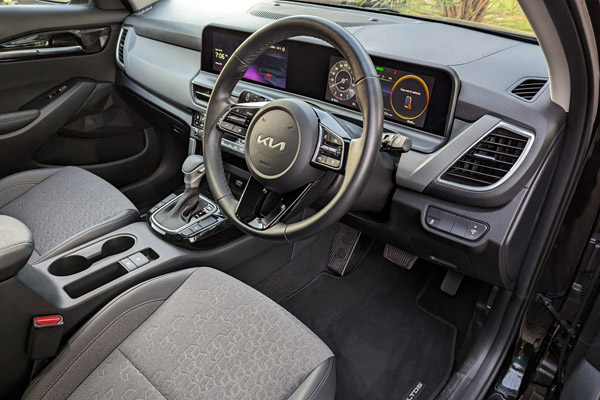
USB-A and USB-C ports are provided in the front along with a 12- volt outlet, with another
pair of USB-C ports for the rear seat.
With complimentary access for seven years, Kia Connect drivers allows drivers to sync
calendars, plan journeys with online navigation and access onboard features including live
traffic alerts and real-time weather forecasts.
ENGINES / TRANSMISSIONS
The 2.0-litre Atkinson style engine with multi-point injection, as opposed to better direct
injection, delivers 110kW of power and 180Nm of torque at 4500 revs, compared to the
turbo’s 146kW and 265Nm — the latter from 1600 revs.
It’s hooked up to a CVT style auto that actually does a pretty good job of harnessing the
engine’s limited torque. It offers Eco, Normal and Sport drive modes, but alas no gear
change paddles.
SAFETY
Seltos receives five stars for safety, with six airbags, a rear-view camera and autonomous
emergency braking with car, pedestrian and cyclist detection and junction turning assist.
A lane keep assist system (LKA) with lane departure warning (LDW) and emergency lane
keeping (ELK) is also standard.
There’s also Intelligent Speed Limit Assist (ISLA), Lane Following Assist (LFA), Rear-
Cross Traffic Collision Avoidance Assist (RCCA) and Blind-Spot Collision-Avoidance
Assist (BCA).
Child seat anchor points are provided in the form of three tethers and two Isofix mounting
points.
Head-up display is reserved for the GT-Line.
DRIVING
New Seltos is a very different beast inside. The old-style analogue gauges have been
replaced by a sweeping digital screen across the range. Interestingly, however, when you
take a closer look at the screen, there’s a large gap between the two hidden panels as
shown in our photo which could be put to better use.
Thankfully, physical controls remain for such things as audio volume and temperature
adjustment of the air conditioning system.
The seats are firm but comfortable, with height adjustment along with reach and height
adjustment for the steering wheel.
But the ambience of the interior is let down by an overriding plastic look and feel. Rear
legroom is adequate, depending on how far back the driver is positioned, but a lack of seat
padding could prove uncomfortable over longer distances.
The boot is a good size, but sacrifices a lot of space to a full-size spare, with 433 litres that
expands to 1393 litres when the rear seats are folded.
The look of the instrument panel changes with each drive mode (red for sport of course).
It is possible to change gears manually with the transmission lever and in this mode the
CVT offers eight steps or simulated gears.
While Sport mode the throttle is more responsive, but it generates some surge and
backlash that can be annoying.
Seltos benefits from Australian-tuned suspension and sits securely and is reasonably
smoothly on our bumpy excuse for roads.
Of note turbo models get a more sophisticated multi-link rear suspension that promises
better ride and handling, while 2.0-litre models make do with a simpler torsion beam setup.
Pushed hard the Sport corners impressively flat for an SUV, but being relatively small and
light is more subject to irregularities in the road surface, dancing from side to side.
Pulling out to overtake we were suddenly confronted by an on-coming vehicle, but with
plenty of room we opted to plant the accelerator — unfortunately with no result.
So . . . the 2.0-litre engine has its limits and they are closer than you might think. Speed
Limit Assist has attracted plenty of bad feedback and is likely to be changed with the next
update.
You can set it to adjust the car’s speed to the current speed limit, warn when you are over
the limit or simply turn it off.
In the first two modes warning chimes sound continually with no respect for timed school
zones or bus and heavy vehicle speed limits.
Turn it off and the chimes go away but you’re left without any indication of the speed limit
in the dash.
And it needs to be reconfigured between starts. That’s a bummer, because it’s enough by
itself to turn one off buying the car.
We were getting 7.3L/100km after close to 400km of mixed driving, including 30 minutes of
fast, hard driving along our favourite stretch of backroad.
SUMMING UP
Kia Seltos is an attractive car that offers great value for money.
But the Sport+, particularly with the 2.0-litre engine aboard, feels a little underdone – a
taste of things to come if you’ve got the money.
You’ll pay $3500 for the Sport+ with a turbo and all-wheel drive, or $9000 more for the top-
of-the-line GT-Line with the works.
RATINGS:
Looks: 8/10
Performance: 7/10
Safety: 7.5/10
Thirst: 7.5/10
Practicality: 8/10
Comfort: 7/10
Tech: 7/10
Value: 7.5/10
Overall: 7.4/10
AT A GLANCE
MODEL RANGE
S 2.0 FWD: $29,500
Sport 2.0 FWD: $32,700
Sport+ 2.0 FWD: $35,800
GT-Line 2.0 FWD: $41,500
Sport+ 1.6 AWD: $39,300
GT Line 1.6 AWD: $44,900
Note: These prices do not include government or dealer delivery charges. Contact
your local Kia dealer for drive-away prices.
SPECIFICATIONS: Kia Seltos Sport+ 2.0-litre four-cylinder petrol, CVT, front-wheel drive
five-door wagon
ENGINE:
Capacity: 1.598 litres
Configuration: Four cylinders in line
Maximum Power: 110 kW @ 6200 rpm
Maximum Torque: 180 Nm @ 4500 rpm
Fuel Type: Standard unleaded
Combined Fuel Cycle (ADR 81/02): 6.9 L/100km
CO2 Emissions: 157 g/km
DRIVELINE: CVT, front-wheel drive
DIMENSIONS, WEIGHT AND CAPACITIES:
Length: 4385 mm
Wheelbase: 2630 mm
Width: 1800 mm
Height: 1635 mm
Turning Circle: 10.6 metres
Kerb Mass: 1375 kg
Fuel Tank Capacity: 50 litres
BRAKES:
Front: Ventilated disc
Rear: Solid disc
STANDARD WARRANTY:
Seven years/unlimited kilometres




